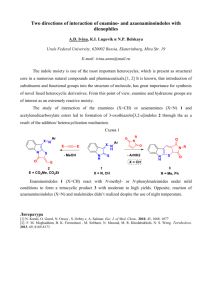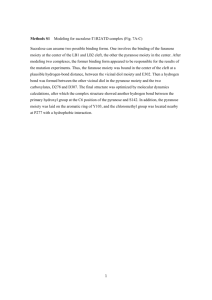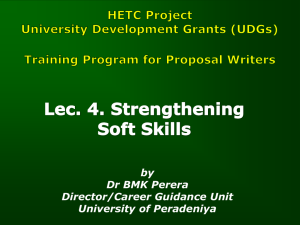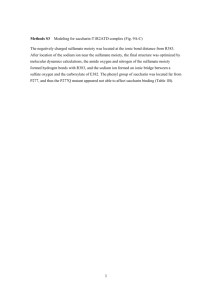藥物投遞系統
advertisement
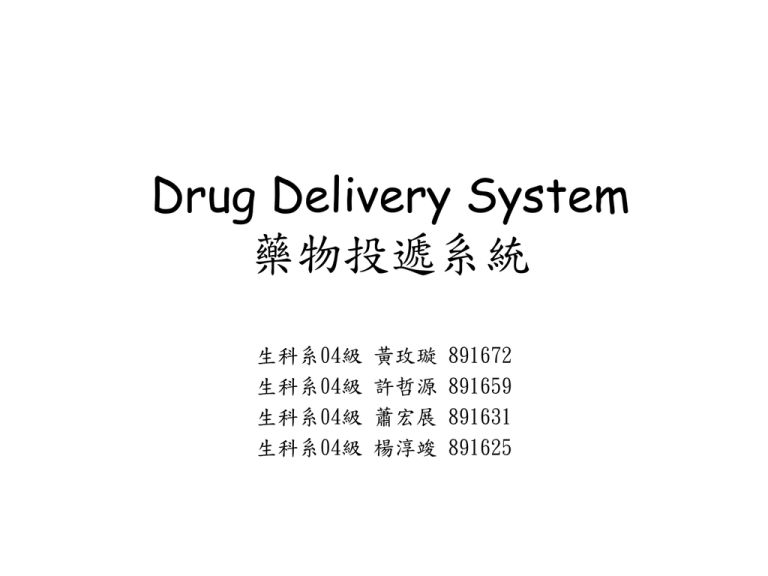
Drug Delivery System 藥物投遞系統 生科系04級 生科系04級 生科系04級 生科系04級 黃玫璇 許哲源 蕭宏展 楊淳竣 891672 891659 891631 891625 藥物投遞系統 (Drug Delivery System) 【必要時將必要限度藥物對必要部位之供應】 2. 市場分析 3. 公司簡介 1. 原理 目標導向 (Target) 傳輸 (Transport) 控釋 (Controlled Release) 藥物釋控系統 黃玫璇 891672 藥物釋控系統 1.何謂藥物釋控 2.發展釋控的優點 3.藥物釋控的種類 A. Diffusion controlled B. Chemically controlled C. Solvent-activated controlled 藥物釋控系統 1.何謂藥物釋控 2.發展釋控的優點 3.藥物釋控的種類 A. Diffusion controlled B. Chemically controlled C. Solvent-activated controlled 【藥物釋控】:Drug Controlled Release System 將藥物以特殊的化學包覆,讓藥物在某一種狀態(如PH值改變)下 適時(ex:延長)適量釋出。 這種控釋劑型的技術發展,目前廣泛地應用於一般的製藥化學工 業中。 藥物釋控系統 1.何謂藥物釋控 2.發展釋控的優點 3.藥物釋控的種類 A. Diffusion controlled B. Chemically controlled C. Solvent-activated controlled Potential Advantages of Controlled Release Systems 1. maintenance of drugs at therapeutically desirable levels 2. the ability to localize drugs to target organs to minimize systemic effects 3. improved patient compliance 4. protection from degradation for drugs with short in vivo lifetimes. Controlled Release vs. Single Dose Single Dosages Controlled Release Concentration Side Effects Desired Range Therapeutic Dose Time 藥物釋控系統 1.何謂藥物釋控 2.發展釋控的優點 3.藥物釋控的種類 A. Diffusion controlled B. Chemically controlled C. Solvent-activated controlled Types of Controlled Release Devices 【 Diffusion controlled】 Diffusion through membrane or bulk polymer 【 Chemically controlled】 polymer erosion: surface erosion, bulk erosion ( combination of erosion and diffusion ) ˙ pendent chain ˙ 【 Solvent-activated controlled】 ˙ osmotic transport of water through semi permeable membrane ˙ water penetration into glassy polymer 1.Diffusion controlled 【 Stomach/Intestine – Liquid】 【 Capsule edge – Gel 】 • Biocompatible polymer 【 Capsule center – Dry 】 • Allows for delayed release release rates are determined by polymer property and partition coefficient of the drug to be released. △advantage ˙ drug diffuses out of matrix at defined rate △disadvantage ˙ efficiency of diffusion of large molecules ˙ danger of ‘dose dumping’ in barrier systems △ 2.Chemically controlled ˙ erosion: Surface erosion, Bulk erosion △ capsule is eroded by the acids in the stomach △ advantage ˙ inject able (micro spheres) ˙ biodegradable (need not be removed surgically) △ disadvantage ˙ difficult to stop once injected 2.Chemically controlled ˙ pendent chain △ drug is covalently bound to the polymer and is released by bond scission owing to water or enzymes 3. Solvent-activated controlled △ the active agent is dissolved or dispersed within a polymeric matrix and is not able to diffuse through that matrix. △ advantage ˙ complex control △ disadvantage ˙ generally more bulky devices and require implantation Biodegradable Polymers Application Targeting moiety for cell 891659 許哲源 Introduction • For the past several decades, researchers and clinicians have been using drugs and radiation to kill tumor cells. • The chemotherapy and radiotherapy are only semiselective for malignant cells. • In contrast, targeting drug therapy has the potential for greater specificity. • With the advent of monoclonal antibody (MoAb) technology, researcher have been able to target different agents to target cells more effectively. Pharmacol. Ther. 1994, 64:127–54 EPR effect • The Enhanced Permeability and Retention effect in tumor tissue • Tumor cells show a higher degree of uptake of macromolecules by endocytosis than normal cell. Microvasc. Res. 1996, 51:327-346 Introduction • Immunotoxins (Its) contain a targeting moiety for delivery and a toxic moiety for cytotoxicity. • The toxins ( plant or bacterial toxin) are catalytic, fewer than 10 molecules in the cytosol of a target cell enough to be lethal. Pharmacol. Ther. 1994, 63(3):209–234 Schematic presentation of ligand-containing, shielded DNA complexes for tumor-targeted gene transfer Journal of Controlled Release 2003, 91:173-181 Targeting Moiety • The targeting agents currently used to construct ITs are MoAbs, growth factors/cytokines, and soluble receptors. • MoAbs are the most frequently used. J. Clin. Immunol. 1992, 12:391–405 Targeting Moiety Targeting Moiety • Bispecific antibodies are novel targeting agents constructed by linking either chemically or genetically two different Fab fragment, one arm of which is directed against a target cell and the other against effector T cells or NK cells (e.g. anti-CD22/anti-CD3RTA). Blood 1993, 82:2224–34 Toxin Moiety • The most commonly used toxic moieties are derived from either bacteria[e.g. Pseudomonas exotoxin(PE) or diptheria toxin(DT)], or plants(e.g. abrin or ricin). Toxin Moiety • Both types of toxins kill cells by inhibiting protein synthesis. – Plant toxins damage 28S rRNA, – Bacterial toxins inactivate EF-2 Ann. Rev. Immunol. 1996. 14:49–71 Linkers • For in vivo therapy, the toxic moiety of the IT must be coupled to the targeting ligand so that it remains stable in the blood and tissues but is separated from the targeting domain for effective translocation into the cytoplasm. Factors affecting the potency of an IT • • • • • Binding affinity of the targeting moiety The density of the target Ag on the cell Naturally internalized or induced to do so. Intracellular routing May promote proliferation of target cell population Clinical trials • The field of immnotoxin therapy is in its infancy. To date most ITs are just entering Phase II/III trials. • Anti-IT antibodies were generated in most trials Conclusions • For the therapy of cancer, ITs have yielded higher response rates in Phase I/II trials than some of the drugs used today. • The generation of new constructs, combinatorial therapy, and in the case of cancer therapy, treatment of tumors that are amenable to IT-mediated killing will eventually result in effective treatment protocols. References • Thrush GR., Lark LR., Clinchy BC., and Vitetta ES. Immunotoxins: An update. Ann. Rev. Immunol. 14: 49-71. 1996. • Rustamzadeh E., Low WC., Vallera DA., and Hall WA. Immunotoxin therapy for CNS tumor. Journal of Neuro-oncology. 64: 101-116. 2003. • Houshmand P., and Zlotnik A. Targeting tumor cells. Current Opinion in Cell Biology. 15: 640-644. 2003 • Ogris M., Walker G., Blessing T., Kircheis R., Wolschek M., and Wagner E. Tumor-targeted gene therapy: strategies for the preparation of ligand-polyethylene glycol-polyethylenimine/DNA complexes. Journal of Controlled Release. 91: 173-181. 2003 • Carlsson J., Aronsson EF., Hietala SO., Stigbrand T., and Tennvall J. Tumuor therapy with radionuclides: assessment of progress and problems. Radiotherapy and Oncology. 66: 107-117. 2003. Overview of Worldwide Drug Market 主講:蕭宏展 Worldwide drug market sales 2003全球各區域藥品市場銷售額 區域銷售率 北美 Total sales: around 5000億美金 歐洲地區 8% 4% 11% 日本 49% 28% 資料來源:IMS Health 亞洲(不包含日 本)、非洲、澳 洲 拉丁美洲 全球十大藥物銷售 Drug delivery system market • 2002年 worldwide sales: $41.1 billion • 2007年(e) worldwide sales: $66 billion Transmuco sal, 7% Transderm al, 10% Pulmonary, 19% Polymer, 10% market share Oral controlled release Polymer others, 1% Oral controlled release, 53% Pulmonary Transdermal Transmucosal others 資料來源:Front Line Strategic Consulting, Inc. Drug delivery system Drug delivery system Oral controlled release Polymer Pulmonary Transdermal Transmucosal others Oral controlled release • Sustained release or extended release drug • Compound is less susceptible to gastric degradation • Company:Elan Corp. and J&J Alza • Product:Nexium (R) Esomeprazole ($3302 millino) 、Losec/Prilosec for treatment of gastric ulcer . Polymer • A method of drug delivery in which a therapeutic is encapsulated in polymeric matrix and is slowly released at the site of action via diffusion and surface erosion. • Inactive in the bloodstream • Company: J&J Alza 、Atrix • Product: PEG-Intron (pegylated interferon) for treatment of chronic hepatitis C Pulmonary • Improve patient compliance associated with the relative comfort and convenience of inhalers. • Company: GlaxoSmithKline、Aerogen,Inc.、 Nektar therapeutics • Product: Aerodose® Insulin Inhaler、 Seretide/Advair for treatment of asthma Transdermal • Enable the passage of drug molecules across skin • Lower dosing of medications result in few adverse side effects • Company: J&J Alza 、Noven Pharmaceutical • Product: Catapres-TTS® (clonidine) for treatment of hypertension 、 NicoDerm® CQ® (nicotine) and Clear NicoDerm® CQ® Transmucosal • Drug is introduced to the body across a mucous membrane which allows for the avoidance of the gastrointestinal tract and first pass liver metabolism and consequently allows the therapeutic to directly enter into circulation. • Company: Nastech Pharmaceutical Co. 、Pherin Pharmaceuticals • Product:Premarin (estrogen) for treatment of symptom of menopause in women. Nasonex for treatment of specific allergy situation Major drug delivery company stock 2004.5.4 Name Last change ALKERMES INC 15.42 +0.08 +0.52% ANDRX GROUP 23.37 +0.53 +2.32% ATRIX LABS 31.34 +1.18 +3.91% BIOVAIL CORP 19.5 +0.50 +2.63% CIMA LABS 31.95 +0.26 +0.82% ELAN CORP PLC 22.03 +0.43 +1.99% FLAMEL TECHNOL 27.94 +1.58 +5.99% NASTECH PHARM 13.94 +0.06 +0.43% NEKTAR THERAP 21.49 資料來源:www.pharmcast.com +1.22 +6.02% ALZA • 1968 ALZA Corporation was founded by Dr. Alejandro Zaffaroni in 1968 to realize his vision of sophisticated pharmaceutical products that precisely control the targeting, timing and dosing of therapeutic compounds. Products • OROS® Technology (11) • D-TRANS® Transdermal Technology (7) Catapres-TTS® (clonidine), Duragesic® (fentanyl), Estraderm® (estradiol), NicoDerm® (nicotine), Transderm-Nitro® (nitroglycerin) • STEALTH® Liposomal Technology Doxil® (doxorubicin) an anti-cancer drug for the treatment of ovarian cancer • DUROS® Implant Technology Viadur® (leuprolide acetate implant) treatment for prostate cancer • 1995 Pfizer introduces Glucotrol XL®, its second oncedaily product using ALZA's OROS® technology. It is introduced as an adjunct to diet for the control of hyperglycemia in patients with non-insulin dependent diabetes. • 2001 ALZA Becomes a Member of the Johnson & Johnson Family of Companies ALZA continues as a leader in the development and manufacture of pharmaceutical products incorporating its novel, proprietary drug delivery technologies for its partners in the global healthcare industry. Biogen Idec (BIIB) • In November 2003, Biogen Idec Inc. was formed from the merger of two of the world’s leading biotechnology companies, Biogen, Inc. and IDEC Pharmaceuticals Corporation. • Core therapeutic areas are in neurology, oncology, and dermatology http://www.biospace.com/company_profile.cfm?CompanyID=1303 http://www.biogenidec.com/site/025.html RITUXAN (R) • RITUXAN (Rituximab): monoclonal antibody of CD20, for treatment of nonHodgkin's lymphoma (NHL) • Approved by FDA in November 1997 • Revenues for the first quarter of 2004: $542 million • RITUXAN (R):$134 million , about 25% and in U.S. $362 million http://quote.money.cnn.com/quote/quote?symbols=biib&submit3.x=29&submit3.y=7 Alkermes • AIR® Pulmonary Drug Delivery System is a proprietary drug delivery technology composed of dry powders ideally suited for delivery to the lungs http://www.biospace.com/company_profile.cfm?CompanyID=1688 • The unique AIR particle is a low density, porous structure with a geometric diameter of 5 - 30 µm * * Particles with mass densities less than 0.4g/cubic centimeter and mean diameters exceeding 5 micrometers were inspired deep into the lungs and escaped the lungs’ natural clearance mechanisms until the inhaled particles delivered their therapeutic payload David A. Edwards,* Justin Hanes,….,SCIENCE.VOL.276.20.JUNE.1997 Ease of use • Due to the inherent features of the AIR particles, a simple breath-actuated inhaler can be utilized without any additional power such as fans or motors. • Alkermes® is developing a family of inhalers that combine compact size with low cost and ease of use 東洋製藥核心技術 1.微脂體劑型 2.緩釋劑型 3.新藥開發 微脂體 •1998年取得第一項微脂體藥品許可證LipoDox針劑. •全球第三家、台灣第一家核准Doxorubicin 微脂體劑型藥物 長效舒緩劑型---釋控技術 •長效劑型愛舒可羅錠Regrow(長效型止咳錠) 取得新藥核可,在1999年上市,突破短效藥 物需服用多次缺點. •長效化痰劑與解熱鎮痛劑,已進入臨床試驗 階段 2000 2001 2002 2003 營收(百萬 745 元) 843 1245 1380 研發金額 63 (百萬元) 員工總數 197 (人) 106 143 222 240 研發人員總 27 數(人) 研發費用/ 8.4% 營收 33 44 12.6 11.5% 研發人員/ 員工總數 14.9 16.7% 13.7% 東洋(4105)之經營績效 單位:億元 年度 期末股本 92 5 91 90 89 88 87 86 85 84 4 3 2 2 2 2 2 2 營業收入 13.8 12.4 8.4 7.5 7.0 5.4 4.3 4.7 3.4 每股營收 (元) 27.5 33.8 30.4 31.3 29.2 25.3 23.3 23.7 17.2 稅前盈餘 2.6 2.5 1.1 0.5 0.5 0.0 0.1 0.2 0.2 稅前EPS 5.2 6.8 4.0 2.1 2.1 0.0 0.5 1.0 1.0 稅後純益 2.4 2.1 1.0 0.4 0.4 0.0 0.1 0.1 0.2 稅後EPS 4.8 5.7 3.6 1.7 1.7 0.0 0.5 0.5 1.0 資料來源:日盛證券 The End
